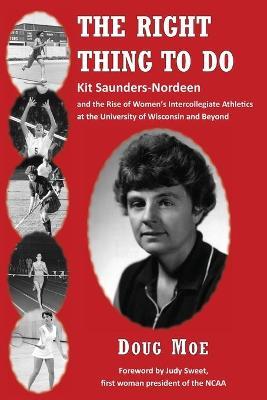The Right Thing to Do

The Right Thing to Do
Published in the 50th anniversary year of the landmark Title IX gender equity legislation becoming law, "The Right Thing to Do" is both a chronicle of the rise of women's intercollegiate athletics in the United States and a biography of one of the movement's leaders, Kit Saunders-Nordeen, the first director of women's athletics at the University of Wisconsin and vice president of the Association for Intercollegiate Athletics for Women (AIAW). When Kit arrived on the Madison campus for graduate school in 1964, competitive athletics for women was actively discouraged. The longtime director of women's physical education at UW-Madison, Blanche Trilling, had been a national voice in advocating participation, but never competition, for women collegians. Across the next decade, Kit changed hearts and minds, establishing a vibrant non-varsity women's sports program at UW. It took some doing. Funds for travel and uniforms were so scarce the athletes sold Christmas trees and did odd jobs to help. The passage of Title IX in 1972 - requiring universities receiving federal funds to not discriminate by gender - provided a boost. Kit was named the UW's first director of women's intercollegiate athletics in 1974, signaling varsity status for women. But Title IX was not a panacea. In 1979, seven years after it became law, the UW women's crew famously changed clothes outside men's athletic director Elroy Hirsch's office because they still didn't have a locker room. A short time later, as women's programs continued to grow, the NCAA - having ignored women's athletics for years - moved to usurp the AIAW, resulting in a bitter battle. Against this backdrop of administrative struggle and intrigue, the young women athletes shined. UW produced celebrated stars like Carie Graves (crew) and Cindy Bremser (track), while earning early national championships in crew and cross-country. The public took notice. In 1990, a women's volleyball match in Madison drew nearly 11,000 fans. Kit Saunders-Nordeen watched that match from the stands with tears in her eyes. Her story, alongside the larger narrative of women intercollegiate athletes refusing to be denied and emerging triumphant, will stir any reader who cares about sports and fair play - on and off the field. As Judy Sweet, the first woman president of the NCAA, who as a student was mentored by Kit in Madison, writes in the book's foreword: "We must remain vi
Published in the 50th anniversary year of the landmark Title IX gende
PRP: 118.49 Lei
Acesta este Pretul Recomandat de Producator. Pretul de vanzare al produsului este afisat mai jos.
106.64Lei
106.64Lei
118.49 LeiLivrare in 2-4 saptamani
Descrierea produsului
Published in the 50th anniversary year of the landmark Title IX gender equity legislation becoming law, "The Right Thing to Do" is both a chronicle of the rise of women's intercollegiate athletics in the United States and a biography of one of the movement's leaders, Kit Saunders-Nordeen, the first director of women's athletics at the University of Wisconsin and vice president of the Association for Intercollegiate Athletics for Women (AIAW). When Kit arrived on the Madison campus for graduate school in 1964, competitive athletics for women was actively discouraged. The longtime director of women's physical education at UW-Madison, Blanche Trilling, had been a national voice in advocating participation, but never competition, for women collegians. Across the next decade, Kit changed hearts and minds, establishing a vibrant non-varsity women's sports program at UW. It took some doing. Funds for travel and uniforms were so scarce the athletes sold Christmas trees and did odd jobs to help. The passage of Title IX in 1972 - requiring universities receiving federal funds to not discriminate by gender - provided a boost. Kit was named the UW's first director of women's intercollegiate athletics in 1974, signaling varsity status for women. But Title IX was not a panacea. In 1979, seven years after it became law, the UW women's crew famously changed clothes outside men's athletic director Elroy Hirsch's office because they still didn't have a locker room. A short time later, as women's programs continued to grow, the NCAA - having ignored women's athletics for years - moved to usurp the AIAW, resulting in a bitter battle. Against this backdrop of administrative struggle and intrigue, the young women athletes shined. UW produced celebrated stars like Carie Graves (crew) and Cindy Bremser (track), while earning early national championships in crew and cross-country. The public took notice. In 1990, a women's volleyball match in Madison drew nearly 11,000 fans. Kit Saunders-Nordeen watched that match from the stands with tears in her eyes. Her story, alongside the larger narrative of women intercollegiate athletes refusing to be denied and emerging triumphant, will stir any reader who cares about sports and fair play - on and off the field. As Judy Sweet, the first woman president of the NCAA, who as a student was mentored by Kit in Madison, writes in the book's foreword: "We must remain vi
Published in the 50th anniversary year of the landmark Title IX gende
Detaliile produsului








